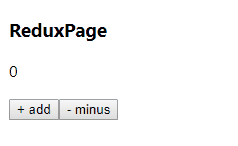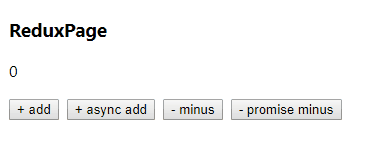# React全家桶 - Redux篇

# 1. 功能列表
- [x] createStore 创建store
- [x] reducer 初始化、修改状态函数
- [x] getState 获取状态值
- [x] dispatch 提交更新
- [x] subscribe 变更订阅
- [x] applyMiddleware 支持中间件
# 2. 中间件
- [x] mini-redux-thunk 异步
- [x] mini-redux-logger 日志
- [x] mini-redux-promise 支持promise
# 3. 函数式编程
推荐资源:
函数式编程入门教程 - 阮一峰的网络日志 (ruanyifeng.com) (opens new window)
第 1 章: 我们在做什么? · 函数式编程指北 (gitbooks.io) (opens new window)
两个最基本的运算:合成(compose)和柯里化(Currying)
# 3.1 合成(compose)
如果一个值要经过多个函数,才能变成另外一个值,就可以把所有中间步骤合并成一个函数,这叫做"函数的合成"(compose)
function fun1(arg) {
return arg + 1;
}
function fun2(arg) {
return arg + 2;
}
function fun3(arg) {
return arg + 3;
}
function compose(...funcs) {
if (funcs.length === 0) {
// 返回一个匿名函数,然后再对匿名函数进行执行, ()()
// arg: 调用compose传入的参数,如: compose()(1)
return arg => arg;
}
if (funcs.length === 1) {
// 返回函数
return funcs[0];
}
// 利用reduce
return funcs.reduce((f1, f2) => (...args) => f1(f2(...args)));
}
const result = compose(fun1, fun2, fun3)(0); // fun1(fun2(fun3(0)))
console.log(result) // 0+1+2+3
# 3.2 柯里化(Currying)
fun1(x) 和 fun2(x) 要合并为一个函数fun1(fun2(x)),有一个前提是fun1和fun2都只有一个参数,那么如果可以接受多个参数,fun1(x, y) 和 fun2(x, y, z),函数合并就比价麻烦了。
"柯里化",就是把一个多参数的函数,转化为单参数函数。有了柯里化以后,我们就能做到,所有函数只接受一个参数。
// 柯里化之前
function add(x, y) {
return x + y;
}
add(1, 2) // 3
// 柯里化之后
function addX(y) {
return function (x) {
return x + y;
};
}
addX(2)(1) // 3
# 4. mini版实现
# 4.1 通过原库实现
思路:先使用一个简单的页面,使用Redux和React搭建起来,然后再自己实现对应的函数。
page
import React, { Component } from 'react';
import store from '../store';
export default class ReduxPage extends Component {
// 如果点击按钮不能更新,查看是否订阅(subscribe)状态变更。
componentDidMount() {
this.unsubscribe = store.subscribe(() => {
this.forceUpdate();
});
}
componentWillUnmount() {
if (this.unsubscribe) {
this.unsubscribe();
}
}
add = () => {
store.dispatch({ type: 'ADD' });
};
minus = () => {
store.dispatch({ type: 'MINUS' });
};
render() {
return (
<div>
<h3>Redux Page</h3>
<p>{store.getState()}</p>
<button type="button" onClick={this.add}> + add</button>
<button type="button" onClick={this.minus}> - minus</button>
</div>
);
}
}
store
import { createStore } from 'redux';
function countReducer(state = 0, action) {
switch (action.type) {
case 'ADD':
return state + 1;
case 'MINUS':
return state - 1;
default:
return state;
}
}
const store = createStore(countReducer);
export default store;
效果

# 4.2 分析
点击按钮 => 执行store.dispatch函数 (参数只能支持对象) => store由redux的countReducer方法创建 (参数就是我们定义的reducer纯函数) => 页面通过store.getState()获取到store的数据 => 想要页面更新,必须使用store.subscribe订阅状态变更 => store数据改变后会触发subscribe,然后页面调用forceUpdate就更新页面了
总结:redux需要下面的函数
- dispatch 提交更新
- createStore 创建store
- getState 获取状态值
- subscribe 变更订阅
# 4.3 createStore
调用这个函数返回store,store里面包含dispatch,subscribe,getState
// function countReducer(state = 0, action) {
// switch (action.type) {
// case 'ADD':
// return state + 1;
// case 'MINUS':
// return state - 1;
// default:
// return state;
// }
// }
// const store = createStore(countReducer); 传入了定义的reducer
export default function createStore(reducer) {
let currentState;
const currentListeners = [];
function getState() {
return currentState;
}
// store.dispatch({ type: 'ADD' }); 传入了一个action
function dispatch(action) {
// 执行一下reducer
currentState = reducer(currentState, action);
// 数据更新后,把所有的listener执行一遍
currentListeners.forEach(listener => listener());
}
// 传入了一个回调函数,数据更新了,就执行这个回调
function subscribe(listener) {
currentListeners.push(listener);
// 组件摧毁的时候,需要取消订阅
return () => {
currentListeners.filter(item => item !== listener);
};
}
// 初始值,手动发一个dispatch,为避免和用户创建的一样,源码里面采用了随机字符串。
dispatch({ type: 'REDUX/MIN_REDUX' });
return {
subscribe,
getState,
dispatch
};
}
然后把咋们store里面引入redux的位置替换为我们的createStore就完成了。
import { createStore } from 'redux'; // 替换下store中createStore函数路径
# 5. 中间件
默认情况下,createStore() (opens new window) 所创建的 Redux store 没有使用 middleware (opens new window),所以只支持 同步数据流 (opens new window)。
你可以使用 applyMiddleware() (opens new window) 来增强 createStore() (opens new window)。
# 5.1 使用中间件
咋们在page页里面添加两个按钮并绑定事件
asyncAdd = () => {
store.dispatch((dispatch) => {
setTimeout(() => {
dispatch({ type: 'ADD' });
}, 1000);
});
}
promiseMinus = () => {
store.dispatch(Promise.resolve({
type: 'MINUS',
payload: 1000
}));
}
<button style={{ margin: '0 8px' }} type="button" onClick={this.asyncAdd}> + async add</button>
<button style={{ margin: '0 8px' }} type="button" onClick={this.promiseMinus}> - promise minus</button>
上面代码中,dispatch中我们传入了一个函数,以及Promise。
在store中引入redux-promise支持promise, redux-thunk支持异步数据, redux-logger打印store数据变更日志。
import { applyMiddleware, createStore } from 'redux';
import promise from 'redux-promise';
import thunk from 'redux-thunk';
import logger from 'redux-logger';
const store = createStore(countReducer, applyMiddleware(thunk, logger, promise));
效果如下:

# 5.2 applyMiddleware
由上面的用法,我们可以看出,applyMiddleware支持传入多个中间件,作用为增强store的功能,使dispatch支持Promise和异步数据流。
createStore函数目前支持两个参数了,但是我们上面写的代码只支持一个参数。添加下面的代码,如果有第二个参数就把第二个参数执行了,我们需要增加store所有传入了参数store,然后执行的时候,需要用到reducer。
export default function createStore(reducer, enhancer) {
if (enhancer) {
return enhancer(createStore)(reducer);
}
......
}
applyMiddleware实现
import compose from './compose';
export default function applyMiddleware(...middlewares) {
// createStore就是我们实现的createStore函数,支持两个参数,一个参数是reducer,第二个参数是enhancer
// args就是我们执行第二个参数enhancer时传入参数 => reducer, 这里具体的就是countReducer
return createStore => (...args) => {
// 柯里化,执行一下只传入第一个参数的createStore,我们就获取到了store,store里面有dispatch
const store = createStore(...args);
let { dispatch } = store;
// 获取到dispatch后,我们需要对它进行增强
const middlewareAPI = {
getState: store.getState,
// disptch原本有哪些参数,都传进去
dispatch: (...params) => dispatch(...params)
};
// 传入每个中间件都需要的getState和需要加强的dispatch
const chain = middlewares.map(middleware => middleware(middlewareAPI));
// 执行每一个中间件就ok了,利用到了我们上面写的compse函数。
// 这里有点绕,需要弄懂compose函数,到底在干啥。
// applyMiddleware(thunk, logger, promise)使用的时候,我们传入了3个中间件
// 使用compose 等价于 thunk(logger(promise(dispatch)))
// 第一次执行promise,返回一个回调函数, 第二次执行logger同样返回一个回调函数,最后执行完thunk时,才会执行外部的真正的回调函数
dispatch = compose(...chain)(store.dispatch);
return {
...store,
// 返回增强后的dispatch
dispatch
};
};
}
# 5.3 redux-logger
先来实现一个最简单的redux-logger, 打印store的变化
// const chain = middlewares.map(middleware => middleware(middlewareAPI));
// 在上面的代码中,我们传入了middlewareAPI,解构获取到getState
export default function logger({ getState }) {
// compose聚合函数中,执行reduce的时候,fn1和f2,next就是f1。
return next => action => {
console.log('***********************************');
console.log(`action ${action.type} @ ${new Date().toLocaleString()}`);
// 执行一下getState(),获取当前的state。
const prevState = getState();
console.log('prev state', prevState);
// 执行dispatch
const returnValue = next(action);
// 获取到执行后的state
const nextState = getState();
console.log('next state', nextState);
console.log('***********************************');
return returnValue;
};
}
# 5.4 redux-thunk
export default function thunk({ getState, dispatch }) {
return next => action => {
// 如果dispatch传入的是一个函数,那么执行这个函数,执行完这个函数后,返回一个函数,就进入回调了
if (typeof action === 'function') {
return action(dispatch, getState);
}
return next(action);
};
}
# 5.5 redux-promise
import isPromise from 'is-promise';
// 简版
export default function promise({ dispatch }) {
return next => action => (isPromise(action) ? action.then(dispatch)
: next(action));
}
# 6. combineReducers
项目中不可能只有一个Reducer,这个时候就需要combineReducers来把所有Reducer合并为一个了。
# 6.1 用法
page
addTodo = () => {
store.dispatch({ type: 'ADD_TODO', payload: ' world!' });
}
<h2>Redux Page</h2>
<h4>Count</h4>
<p>{store.getState().count}</p>
<h4 style={{ marginTop: '24px' }}>Todo</h4>
<p>{store.getState().todos}</p>
<button type="button" onClick={this.addTodo}>添加todo</button>
store
import { applyMiddleware, createStore, combineReducers } from 'redux';
function todoReducer(state = ['hello'], action) {
switch (action.type) {
case 'ADD_TODO':
return state.concat([action.payload]);
default:
return state;
}
}
// 只有一个reducer
// const store = createStore(countReducer, applyMiddleware(thunk, logger, promise));
// 多个reducer合并
const store = createStore(
combineReducers({
count: countReducer,
todos: todoReducer
}),
applyMiddleware(thunk, logger, promise)
);
# 6.2 实现
export default function combineReducers(reducers) {
return function combination(state = {}, action) {
const nextState = {};
let hasChanged = false;
Object.keys(reducers).forEach(key => {
const reducer = reducers[key];
nextState[key] = reducer(state[key], action);
hasChanged = hasChanged || nextState[key] !== state[key];
});
// 源码里面提供了replaceReducer,
// replaceReducer => {a: 0, b: 1} 替换为了{a: 0}
// 所以需要比较两次的length发生变化没有
hasChanged = hasChanged || Object.keys(nextState).length !== Object.keys(state).length;
return hasChanged ? nextState : state;
};
}
# 7.bindActionCreator
配合react-redux使用,文档 (opens new window)
实现
function bindActionCreator(actionCreator, dispatch) {
return (...args) => dispatch(actionCreator(...args));
}
// 用法,给creators添加dispatch
// let creators = {
// add: () => ({ type: 'ADD' }),
// minus: () => ({ type: 'MINUS' })
// };
// creators = bindActionCreators(creators, dispatch);
export default function bindActionCreators(actionCreators, dispatch) {
const boundActionCreators = {};
Object.keys(actionCreators).forEach(key => {
const actionCreator = actionCreators[key];
boundActionCreators[key] = bindActionCreator(actionCreator, dispatch);
});
}
# 结尾
仓库地址:https://github.com/claude-hub/build-my-own-react (opens new window),求star~。